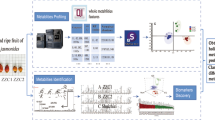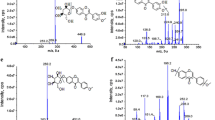Abstract
Leaves from a natural population of Artemisia princeps var. orientalis (Pamp.) H. Hara were collected monthly from April through October and characterized for composition of secondary metabolite compounds and their phytotoxic effects on seed germination and seedling growth of Achyranthes japonica and Lactuca sativa. The compounds were identified using gas chromatography/mass spectrometry (GC/MS) coupled with a solvent-free solid injector (SFSI). GC/MS analyses of all samples revealed qualitative variability in the composition of secondary metabolites. The greatest number of compounds was identified in July (56) followed by September (30) and April (24), and the lowest number was found in June (2) and August (2). Among 92 compounds, the major compounds were various terpenes (23) (mono-, sesqui, di-, and tri-terpenes) followed by heterocyclic compounds (18) and hydrocarbons (14). The higher the concentration of the secondary metabolites, the lower the seed germination and seedling growth of A. japonica and L. sativa. Plant samples collected in July and August were most detrimental. Taken together, variability in the secondary metabolites compounds of A. princeps var. orientalis was verified during different seasons, and the compounds were successfully identified by a combination of SFSI and GC/MS. Notably, the antimicrobial and antioxidative effects were inconsistent throughout the various seasons.



Similar content being viewed by others
References
Abd El-Aty AM, Kim IK, Kim MR, Lee CH, Shim JH (2008) Determination of volatile organic compounds generated from fresh, white and red Panax ginseng (C. A. Meyer) using a direct sample injection technique. Biomed Chromatogr 22(5):556–562
Ahmed A, Misra LN (1994) Terpenoids from Artemisia annua and constituents of its essential oil. Phytochemistry 37:183–186
Amini S, Azizi M, Joharchi MR, Shafei MN, Moradinezhad F, Fujii Y (2014) Determination of allelopathic potential in some medicinal and wild plant species of Iran by dish pack method. Theor Exp Plant Physiol 26:189–199
Angelopoulou D, Demetzos C, Perdetzoglou D (2002) Diurnal and seasonal variation of the essential oil labdanes and clerodanes from Cistus monspeliensis L. leaves. Biochem Syst Ecol 30:189–203
Araniti F, Lupini A, Sorgonà A, Conforti F, Marrelli M, Statti GA, Menichini F, Abenavoli MR (2013) Allelopathic potential of Artemisia arborescens: isolation, identification and quantification of phytotoxic compounds through fractionation-guided bioassays. Nat Prod Res 27:880–887
Barney JN, Hay AG, Weston LA (2005) Isolation and characterization of allelopathic volatiles from mugwort (Artemisia vulgaris). J Chem Ecol 31(2):247–265
Choi EJ, Kim GH (2013) Antioxidant and anticancer activity of Artemisia princeps var. orientalis extract in HepG2 and Hep3B hepatocellular carcinoma cells. Chin J Cancer Res 25(5):536–543
Chon SU, Kim YM, Lee JC (2003) Herbicidal potential and qualification of causative allelochemicals from several compositae weeds. Weed Res 43:444–450
Dudareva N, Negre F (2005) Practical application of research into the regulation of plant volatile emission. Plant Biol 8:113–118
Einhellig FA (2002) The physiology of allelochemical action: clues and views. In: Reigosa MJ, Pedrol N (eds) Allelopathy, from molecules to ecosystems. Science Publishers, Enfield
Eom SH, Yang HS, Weston LA (2006) An evaluation of the allelopathic potential of selected perennial groundcovers: foliar volatiles of catmint (Nepeta × faassenii) inhibit seedling growth. J Chem Ecol 32:1835–1848
Fabiyi OA, Atolani O, Adeyemi OS, Olatunji GA (2012) Antioxidant and Cytotoxicity of β-Amyrin acetate fraction from Bridelia ferruginea Leaves. Asian Pac J Trop Biomed 2:S981–S984
Goff SA, Klee HJ (2006) Plant volatile compounds: sensory cues for health and nutritional value? Science 311:815–819
Hall GD, Langenheim JH (1987) Geographic variation in leaf monoterpenes of Sequoia sempervirens. Biochem Syst Ecol 15:31–43
Hamm S, Lesellier E, Bleton J, Tchapla A (2003) Optimization of headspace solid phase microextraction for gas chromatography/mass spectrometry analysis of widely different volatility and polarity terpenoids in olibanum. J Chromatogr A 1018:73–83
Hashidoko Y, Tahara S, Mizutani J (1989) Antimicrobial sesquiterpene from damaged Rosa rugosa leaves. Phytochemistry 28(2):425–430
Hosking R (1997) A dictionary of Japanese food. Tuttle Publishing, Tokyo, Japan, p 175. ISBN 978-0804820424
Kavitha A, Prabhakar P, Narasimhulu M, Vijayalakshmi R, Venkateswarlu Y, Rao KV, Raju VB (2010) Isolation, characterization and biological evaluation of bioactive metabolites from Nocardia levis MK-VL_113. Microbiol Res 165(3):199–210
Keawsa-ard S, Kongtaweelert S (2012) Antioxidant, antibacterial, anticancer activities and chemical constituents of the essential oil from Mesua ferrea leaves. Chiang Mai J Sci 39(3):455–463
Kegode G, Ciernia M, Vlieger D (2012) Allelopathic potential of Artemisia biennis (biennial wormwood). Agric Sci 3:582–587. doi:10.4236/as.2012.34070
Keys JD (1976) Chinese herbs, 1st edn. Charles E. Tuttle, Tokyo, p 219
Kil BS, Yun KW (1992) Allelopathic effects of water extracts of Artemisia princeps var. orientalis on selected plant species. J Chem Ecol 18:39–51
Kim JH (1996) Seasonal variation in concentration and composition of monoterpenes from Artemisia princeps var. orientalis. Korean J Ecol 19(4):321–328
Kim YS, Kim MN, Kim JO, Lee JH (1994) The effect of hot water-extract and flavor compounds of Mugwort on microbial growth. Korean Soc Food Nutr 23:994–1000
Kim MR, Abd El-Aty AM, Kim IS, Shim JH (2006) Determination of volatile flavor components in danggui cultivars by solvent free injection and hydrodistillation followed by gas chromatographic–mass spectrometric analysis. J Chromatogr A 1116(1–2):259–264
Kim IK, Abd El-Aty AM, Shin HC, Lee HB, Kim IS, Shim JH (2007) Analysis of volatile compounds in fresh healthy and diseased peppers (Capsicum annuum L.) using solvent free solid injection coupled with gas chromatography-flame ionization detector and confirmation with mass spectrometry. J Pharm Biomed Anal 45:487–494
Ko AY, Musfiqur Rahman M, Abd El-Aty AM, Jang J, Choi JH, Mamun MI, Shim JH (2014) Identification of volatile organic compounds generated from healthy and infected powdered chili using solvent-free solid injection coupled with GC/MS: application to adulteration. Food Chem 156:326–332
Legault J, Pichette A (2007) Potentiating effect of beta-caryophyllene on anticancer activity of alpha-humulene, isocaryophyllene and paclitaxel. J Pharm Pharmacol 59(12):1643–1647
Liu CH, Mishra RX, Tan RX, Tang C, Yang H, Shen YF (2006) Repellent and insecticidal activities of essential oils from Artemisia princeps and Cinnamomum camphora and their effect on seed germination of wheat and broad bean. Bioresour Technol 97:1969–1973
Mamede MEO, Pastore GM (2006) Study of methods for the extraction of volatile compounds from fermented grape must. Food Chem 96(4):586–590
Manorenjitha MS, Norita AK, Norhisham S, Asmawi MZ (2013) GC–MS analysis of bioactive components of Ficus religiosa (linn.) stem. Int J Pharma Biosci 4(2):99–103
McLafferty FW, Stauffer DB (1989) The Wiley/NBS registry of mass spectral data. Wiley, New York
Nugroho A, Lee KR, Alam MB, Choi JS, Park HJ (2010) Isolation and quantitative analysis of peroxynitrite scavengers from Artemisia princeps var. orientalis. Arch Pharmacal Res 33(5):703–708
Park JC, Yu YB, Lee JH, Kim NJ (1994) Studies on the chemical components and biological activities of edible plants in Korea (VI)-Anti-inflammatory and analgesic effects of Cedrela sinensis, Oenanthe javanica and Artemisia princeps var. orientalis. Korean Soc Food Nutr 23(1):116–119
Rothschild M, Moore BP, Brown WV (1984) Pyrazines as warning odour components in the Monarch butterfly, Danaus plexippus, and in moths of the genera Zygaena and Amata (Lepidoptera). Biol J Linn Soc 23(4):375–380
Rothschild M, Bergström G, Wängberg S (2005) Cannabis sativa: volatile compounds from pollen and entire male and female plants of two variants, Northern Lights and Hawaiian Indica. Bot J Linn Soc 147:387–397
Roussis V, Tsoukatou M, Petrakis PV, Chinou I, Skoula M, Harborne JB (2000) Volatile constituents of four Helichrysum species growing in Greece. Biochem Syst Ecol 28:163–175
Sarath VJ, So CS, Won YD, Gollapudi S (2007) Artemisia princeps var. orientalis induces apoptosis in human breast cancer MCF-7 cells. Anticancer Res 27(6B):3891–3898
Shobha RP, Agrawal R (2007) Volatile compounds of therapeutic importance produced by Leuconostoc paramesenteroides, a native laboratory isolate. Turk J Biol 31:35–40
Singh HP, Kaur S, Mittal S, Batish DR, Kohli RK (2008) Phytotoxicity of major constituents of the volatile oil from leaves of Artemisia scoparia Waldst. & Kit. Z Naturforsch C 63:663–666
Toda S (2004) Inhibitory effects of polyphenols in leaves of Artemisia princeps PAMP on protein fragmentation by Cu(II)–H2O2 in vitro. J Med Food 7(1):52–54
Toda S (2005) Antioxidative effects of polyphenols from leaves of Artemisia princeps Pamp. on lipid peroxidation in vitro. J Food Biochem 29:305–312
Umano K, Hagi Y, Nakahara K, Shoji A, Shibamoto T (2000) Volatile chemicals identified in extracts from leaves of Japanese mugwort (Artemisia princeps Pamp.). J Agric Food Chem 48:3463–3469
Venkata Raman B, Samuel LA, Pardha Saradhi M, Narashimha Rao B, Naga Vamsi krishna A, Sudhakar M, Radhakrishnan TM (2012) Antibacterial, antioxidant activity and GC-MS analysis of Eupatorium odoratum. Asian J Pharm Clin Res 5:99–106
Yun KW, Choi SK (2003) Seasonal variation in allelopathic potential of Artemisia princeps var. orientalis on plants and microbes. J Plant Biol 46(2):105–110
Yun KW, Kil BS (1992) Assessment of allelopathic potential in Artemisia princeps var. orientalis residues. J Chem Ecol 18:1933–1940
Yun KW, Jung HJ, Kim JH (2008) The influence of the growth season on the antimicrobial and antioxidative activity in Artemisia princeps var. orientalis. Ind Crops Prod 27:69–74
Acknowledgments
This study was supported by the MSIP (Ministry of Science, ICT and Future Planning).
Author information
Authors and Affiliations
Corresponding authors
Rights and permissions
About this article
Cite this article
Mamun, M.I.R., Abd El-Aty, A.M., Musfiqur Rahman, M. et al. Characterization of secondary metabolite compounds correlated with the seasons in Artemisia princeps var. orientalis (Pamp.) H. Hara leaves using direct sample injection and gas chromatography–mass spectrometry: contribution to phytotoxicity. J Korean Soc Appl Biol Chem 58, 173–183 (2015). https://doi.org/10.1007/s13765-015-0020-3
Received:
Accepted:
Published:
Issue Date:
DOI: https://doi.org/10.1007/s13765-015-0020-3




